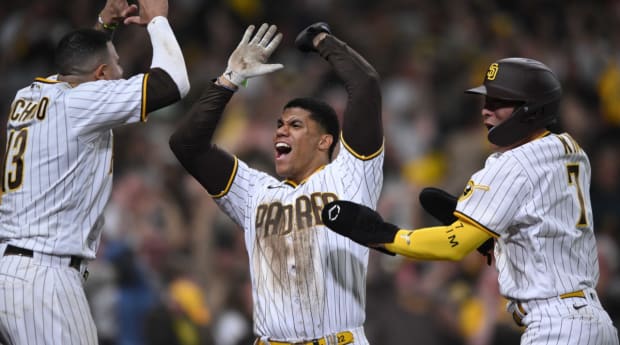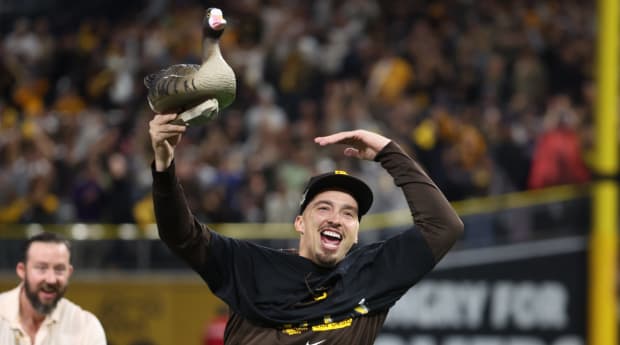SAN DIEGO — A goose on the field, a drone above it, a rainy night in Southern California, the biggest postseason upset in 116 years. Weirdness ruled in this National League Division Series between the Padres and Dodgers. But what might be weirdest of all is how the Padres thoroughly exposed every flaw in a 111-win Dodgers team. It didn’t even look like an upset.
San Diego finished off the series Saturday and advanced to its first NLCS since 1998 by winning its third straight game, each time with its starting pitcher staying in the game longer than the Los Angeles starter. The Dodgers are always in a hurry to get their starting pitcher out of the game, and it burned them in Game 4 when manager Dave Roberts didn’t have enough good arms in his bullpen to make sense of pulling an effective Tyler Anderson after five innings (no runs, two hits, 86 pitches).
The Dodgers walked themselves into a bad situation in which their season was in the hands of Tommy Kahnle and Alex Vesia. Not good, especially not during a season that started with a $310 million payroll. In one inning, a 3–0 lead became a 5–3 deficit and an eventual loss at that score.
In Game 2, Clayton Kershaw gave the Dodgers only five innings in a 5–3 loss. In Game 3, a rusty Tony Gonsolin had nothing and was gone after getting only four outs. In Game 5, Roberts willingly curtailed Anderson’s night because Juan Soto and Manny Machado were due up in the sixth for San Diego.
“There was some thought,” Roberts said about letting Anderson start the sixth, “but I thought where he was at with his pitch count, who was coming up, I just felt that we had enough arms to get through that.
“With a 2–0 lead, Soto, Machado coming up again, I just felt that he’s going to be in the 90s at that point in time. I felt that we had enough coverage.”
This from a man who let Anderson throw 124 pitches when he had a no-hitter in play.
In fairness, don’t blame Roberts. He is inundated with information and “guidelines” with how to run a game from his front office. Before Game 4, Roberts was 45 minutes late for his scheduled media sessions because he was locked up in meetings with his front office number crunchers. They script the game. Roberts is the one who must walk into the media room and answer for when it goes sideways.
I say it every postseason: Far more games are lost by taking out a starter too soon rather than too late. Kyle Hendricks in 2020 is the only starting pitcher in the past five postseasons who was permitted to lose a game late.
It’s a strategy that looks good on paper and is fine if you have a deep, platoon-neutral bullpen like the 2021 Braves, who used relievers for more innings than starters to run through the playoffs to the title.
The Dodgers don’t have that kind of bullpen. They have three 17th-round picks in their bullpen. They rely on matchups with a pitcher’s stuff and the break of his pitches against the arc of hitters’ swings. They believe in relievers throwing their best pitch over and over. There are many data points to rely on, and you can make yourself believe in probabilities. But NLCS Game 4 was an example of what happens when the human element gets in the way of those plans.

Orlando Ramirez/USA TODAY Sports
To tell the story of the anatomy of this defeat—of the end of the Dodgers’ historic season—begin with the decision to pull Anderson. It was done because Roberts (code for the front office) wanted a fresh arm on Soto and Machado the third time around. That arm was Chris Martin, who pitched around two hits. The Dodgers pushed across another run in the top of the seventh.
Now Roberts had a three-run lead with nine outs to get to bring the series back to Dodger Stadium for a Game 5. He planned to save his best reliever, Evan Phillips, for the ninth. That would leave six outs to bridge. He chose to remove Martin for Kahnle, almost entirely because he believed Kahnle’s changeup could neutralize Trent Grisham, the left-handed-hitting Padres right fielder and .184 hitter in the regular season who has become a new Mr. October.
Kahnle threw only 12 2/3 innings during the season because of injuries. He is hardly a reliable winning piece. It was not a good choice. Start with this: He walked the leadoff batter with a 3–0 lead. Then Grisham blew up the strategy further by lining a single—on a first-pitch changeup he knew was coming from Kahnle. Then Austin Nola singled —on another changeup.
Now Roberts was in trouble. He had Yency Almonte—not Phillips—throwing before the inning began, knowing Kahnle was not going to last beyond his required minimum of three batters. But he didn’t want to use Almonte for as many as three outs and he had lost confidence in the stuff of Vesia. Without Phillips to troubleshoot, Roberts was put in a bind by Kahnle not getting even one out.
“Well, to start the inning, I don't expect to have Yency taking down the fourth hitter of the inning,” Roberts said.
Ha-Seong Kim bluffed bunt on the first pitch from Almonte, which brought third baseman Max Muncy onto the grass, after which Kim grounded an RBI double past him. Soto ripped a run-scoring single to tie the game.
Almonte somehow got the next two outs, bringing Jake Cronenworth, a lefty, to the plate. Roberts signaled for Almonte to make a pickoff throw to first to buy more time for Vesia to warm. The Dodgers could not get even that simple play wrong. Almonte, Roberts said, missed the sign and made a pitch to Cronenworth, a ball.
Now Roberts emerged to bring in Vesia with a 1–0 count.
“He was ready,” Roberts said of Vesia. “I just wanted to buy a little bit more time. And that was the thought. I’m not going to put a pitcher in there who doesn’t say that ‘I’m ready to go.’ He was ready, I was just hoping it was going to be 0–0 just to make sure we felt good about it.”
Vesia threw his best pitch, his fastball, two times: one a called strike, another a foul ball. With two strikes and two outs, Soto took off—slowly—for second base, knowing the Dodgers’ infielders were not going to cover second base and open a hole for Cronenworth. The pitch, another fastball, was a ball. Soto sashayed into second. Now two runners were in scoring position.
With a 2-and-2 count, Vesia decided to throw a slider. It was a bad one. Cronenworth laced it into center field. His two-out, two-strike, two-run single in an at bat against two pitchers will become the stuff of Padres legend years from now. It was the dagger that, to borrow from Padres principal owner Peter Seidler, slayed “the dragon up the freeway.”
Give the Padres a world of credit. Like the Phillies, their NLCS opponent, the Padres are an energized, supremely confident collection of young veterans and workhorse starters. San Diego manager Bob Melvin managed a brilliant series. He let Yu Darvish, Blake Snell and Joe Musgrove pitch a third time to the mighty top of the Los Angeles lineup—Mookie Betts, Trea Turner and Freddie Freeman—and won each of those games by not cranking the bullpen carousel early. He did not use a script.
The Padres flashed the “Rally Goose” on the stadium videoboard. When a drone hovered over field, Cronenworth grabbed a baseball and was ready to pelt it before it buzzed away. The rain caused only the second use of the tarp at Petco Park all year, and came down again hard after the winning rally, as if blessing the proceedings.

Orlando Ramirez/USA TODAY Sports
All of it strange, but not as much as the Padres exposing the Dodgers’ every flaw, not just the bullpen. Muncy and Justin Turner had trouble squaring up hittable fastballs, leaving the Los Angeles lineup looking top-heavy. Turner has a $16 million option for next season that probably doesn’t get exercised.
Cody Bellinger looked so bad that Roberts benched him against Musgrove, leaving Bellinger upset and probably staring at being non-tendered. Turner looked skittish at shortstop and is likely gone as a free agent. Trayce Thompson was lightning in a bottle for a while, but a postseason diet of breaking balls neutralized him. Chris Taylor, because of two weeks of rust from a neck injury, was useless. The bottom of the San Diego lineup vastly outplayed the bottom of the Los Angeles lineup.
The Dodgers’ biggest problem when it came to flushing 111 wins is that they had no closer and still hurried starting pitchers out of games. Without Craig Kimbrel (ineffective), Daniel Hudson (hurt) and Blake Treinen (he pitched once and showed he still wasn’t right after an arm injury), Los Angeles was short of playoff-caliber experienced arms, especially to get out lefties like Soto, Cronenworth and Grisham. Brusdar Graterol fell out of favor because he doesn’t get enough strikeouts for the analysts’ tastes.
Before the game, one of the Los Angeles front office executives expressed concern that the team perhaps appeared flat due to a month of playing games that lacked intensity with so little on the line. The Dodgers had the division locked up months ago. There was some truth there—the quality of the Padres’ at bats was vastly superior—but the real concern for the Dodgers was going to the bullpen too soon too often.
“Things could have gone either way today to impact the result of the game,” Roberts said. “It didn't. We got beat in a series.”
He later added when addressing the disappointment of flushing 111 wins: “But you’ve got to give the Padres credit. They outplayed us this series.”
Strange as it seems based on the massive gap in regular-season records, the better team won.







